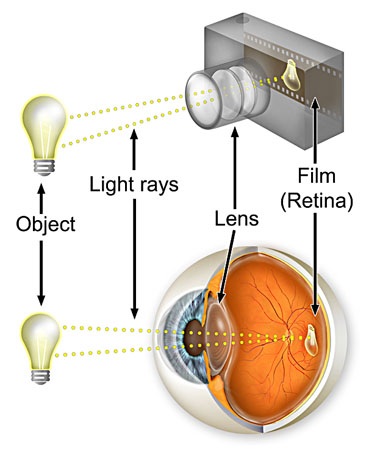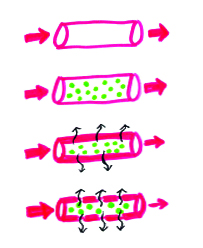Diabetes and Your Eyes

The retina is light-sensitive tissue that lines the inside of the eye. It functions like the film inside a camera. Diabetic Retinopathy is damage to this tissue caused by diabetes.
How does it happen?

Our blood vessels are not designed to hold a lot of sugars. Having high blood sugar puts a lot of stress on your blood vessels.
If your sugars are high for a long period of time, your blood vessels will become thick, weak, and eventually break down. This happens to the blood vessels in your eyes, kidneys, and all over your body.
Over time, your vessels will become weak and leaky. This may cause bleeding or swelling.
With worsening damage, the blood vessels will be unable to carry and deliver blood as it used to. Parts of the eye will not get the blood supply they need, and they will become starved for oxygen.
Early Changes – Non-proliferative Diabetic Retinopathy

The retina is shown in gray – it lines the back of your eye and functions like the film in a camera.
The blood vessels, shown in red, lie along the retina and supplies it with the oxygen and nutrients it needs to survive.
The early stage of diabetic eye disease is called Non-proliferative Diabetic Retinopathy.
Your eye doctor may see small outpouchings, called aneurysms, or a small amount of bleeding from the vessels in the back of your eye.

With further damage, he may also see pale areas in the back of the eye that are not receiving enough oxygen and nutrients.
Late Change – Proliferative Diabetic Retinopathy
The late stage of diabetic eye disease is called Proliferative Diabetic Retinopathy. This occurs if the vessels are so damaged that they are not able to supply the eye with the oxygen and nutrients it needs to survive. Parts of the retina become starved of nutrients, and they begin to produce a chemical that stimulates new blood vessels to grow.
Imagine the normal vessels as a field of grass covering the inside of the eye. These new blood vessels are like weeds – instead of growing along the curvature of the eye like normal vessels, they grow towards the middle of the eye
These new, abnormal blood vessels are prone to break, bleed, and tear the retina – leading to vision loss.
Scarring from bleeding and leaky vessels can cause retinal detachment, where the retina lifts off the back of the eye. This will cause you to see flashing lights, and may result in permanent vision loss.
What can I do?
1. Control your blood sugar – it is the best way to prevent eye disease and damage to your other organs
- Keep a record of your blood sugar levels
- Eat a healthy diet
- Take your diabetes medication
- Be physically active
2. Have a dilated eye exam every year – you may not notice any changes in your vision until it is too late. Diabetic eye disease develops over many years – finding and treating it early can prevent vision loss 95% of the time. Warning signs:
- Blurry vision
- Double vision
- New floaters
- Flashing Lights
- Loss of vision
Who gets Diabetic Eye Disease?
The longer you have had diabetes, the more likely you are to have eye problems
Protect your eyes by:
- Having good control of your blood sugars
- Getting your eyes checked every year
Tests your doctor might order:
Dilate Fundus Exam
- Purpose: Enlarging your pupil so the doctor can take a look inside your eye.
- How it’s done: Eye drops will be used to dilate your eyes (enlarge the pupil) so that the doctor can look inside with some lights and lenses to see if there is any bleeding, swelling, or changes in the blood vessels in the back of your eyes.
Fluorescein Angiography
- Purpose: This test tells us how the blood is moving through the blood vessels in the back of your eye.
- How it’s done: This test uses a mild dye and a camera to look at the blood vessels inside your eyes. Dye will be injected into one of your veins and pictures will be taken of the inside of your eye.
Optical Coherence Tomography (OCT)
- Purpose: This test tells us if there is swelling or leaking in the back of your eye.
- How it’s done: This test is done on a special machine in the office. You will be asked to look at a light while the machine takes pictures of your eye. These pictures are cross-sections, and tells us about the thickness of the back of your eye.
Treatment Options
There are very good treatments to slow diabetic eye disease and stop the damage if the disease is caught early
- Injections – Medications can be injected directly into the eye. These medications stop the chemical signals that stimulate the growth of new blood vessels and prevents the late stage of disease.
- Lasers – Laser treatments are done in the office, and they can help with swelling and bleeding from leaky vessels. They can also be used to stop new vessels from growing.
- If you have late stage disease, you might need a combination of treatments. These might help make your vision better, but the damage may be permanent
- Vitrectomy – This is done in the operating room. If the abnormal vessels break and bleed, the inside of your eye will be filled with blood. This will make your vision cloudy and blurry. The jelly that fills your eyeball is taken out and replaced with clear fluid.
Hope Through Research – You Can Be Part of the Answer!
Many research studies are underway to help us learn about eye diseases. Would you like to find out more about being part of this exciting research? Please visit the following links:
- NIH Clinical Research Trials and You
- Diabetes Eye Disease Studies
- NetWellness Research Center
- ClinicalTrials.gov Explained and Find Studies on ClinicalTrials.gov
- ResearchMatch Explained and Join ResearchMatch
References:
- Diabetic Retinopathy, NIH
- Diabetic Retinopathy Basics, MedWeb UK
- Facts About Diabetic Retinopathy, National Eye Institute
Prepared in partnership with Lily Huang, MD, Class of 2013, Case Western Reserve University School of Medicine.
For more information:
Go to the Eye and Vision Care health topic.




